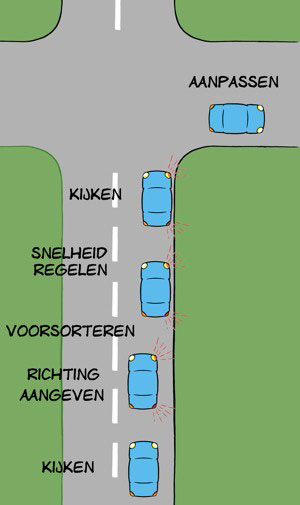Position on the road for turning right or left

Getting in the right lane means choosing the correct position on the carriageway before changing direction.
The RVV states the following about getting in the right lane:
Article 17 of the RVV:
Drivers wishing to turn off may get into the right-hand lane by:
-
- if they wish to turn right, driving on the right-hand side as much as possible in good time.
- If they wish to turn left, they must drive against the axis of the road in good time, or keep to the left as much as possible in single carriageways.
- Drivers should signal with their indicator or arm before turning.
What do you notice? It says that if you want to turn right. you MAY get in lane by driving on the right as far as possible.
However, if you take theory exams at the CBR, it is no longer a may, but a MUST you drive on the right as much as possible.
Also notice that the second paragraph states that you must indicate direction before turning. That makes sense. Less logical is that you may not only do this with the indicator, but this may also be a sign with your arm. Just assume that this does not apply to motorists, but again it does to cyclists, moped riders, moped riders and for motorcyclists, if there is no indicator on the vehicle.
Below, I show what actions you need to take before turning.

- You need to be convinced that you can and may actually turn right, so you need to pay close attention to whether the street is not closed by traffic signs, or whether you cannot enter the street due to roadworks, for example.
- Next, you have to check whether turning right will hinder or can hinder other traffic. You do this by first looking in your rear view mirror, then in the right wing mirror and then over your right shoulder to check the blind spot.
- If it appears that you can turn off without obstructing other traffic, signal to the right.
- Now get as far as right as possible in the lane. Do this in a smooth line and do not obstruct cyclists and mopeds.
- You have to regulate your speed and shift down if necessary so you can take the bend safely.
- Then you have to be careful not to give way to oncoming traffic on the same road or give way to other traffic.
- If it is safe to do so, take a short right turn, without going on the wrong side of the road. You now start paying close attention to traffic signs and adjust your speed to other traffic.

If you want to turn left, you need to do the following:
- You need to be convinced that you can and may actually turn left, so you need to pay close attention to whether the street is not closed by traffic signs, or whether you cannot enter the street due to roadworks, for example.
- Next, you have to check whether turning left will impede or could impede any other traffic. You do this by first looking in your rear view mirror, then in the left wing mirror and after this you look over your left shoulder to the blind spot.
- If it appears that you can turn without obstructing other traffic, you indicate to the left.
- Now get in line against the road axis as much as possible.
- You now regulate your speed and downshift if necessary so you can take the bend safely.
- Next, be careful not to let straight through traffic on the same road or give way to other traffic.
- If it is safe to do so, take a wide left turn, without getting on the wrong side of the road. In any case, do not cut the corner. You now start paying close attention to traffic signs and adjust your speed to other traffic.
